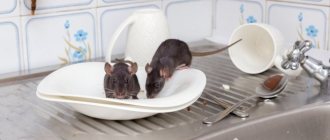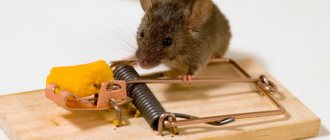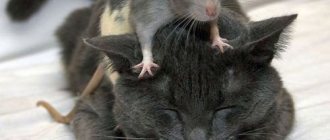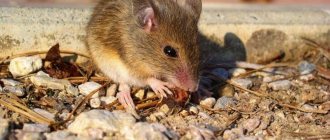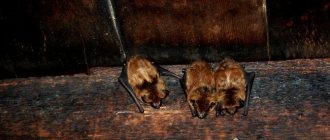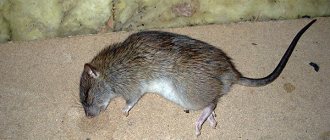Mice only in cartoons evoke sympathy and a good-natured smile. In real life, these rodents pose a serious danger. They spread infectious diseases, spoil food supplies and things, and chew through electrical wires. All this makes life much more difficult for the homeowner.
There are several ways to expel a tailed pest from your home. The choice of product depends on many factors. You need to pay attention to the design features of the room, the presence or absence of small children and pets, and your financial capabilities.
Let's look at the most effective ways to get rid of mice.
Signs of rodent presence
The fight against tailed residents intensifies in autumn and winter. In summer, rodents live in fields because there is enough food there. They move closer to humans in August-September. In the private sector, they first choose sheds, barns and cellars for themselves, because there are a lot of food supplies there, it is warm, cozy and relatively safe.
You can notice their presence by spoiled products stored for storage. Mice happily gnaw on potatoes, beets, carrots, and other root vegetables.
They easily make holes in bags of wheat, corn and other grains. If you notice traces of their feast, then it’s time to start fighting. Another irrefutable evidence of their presence is feces.
6 castles before they turned into ruins: designers restored their appearance
How can a woman keep a man? Advice from Mikhail Zadornov (and the main female mistake)
Down with terry: why you need to include paper towels in your skin care
There is no need to wait for mice to move into living areas. They will do this when frost sets in. In winter, they are very cold in the barn, so they tend to get into the house. If they have absolutely nothing to eat in your home, they begin to chew paper, plastic, candles, even glue and soap.
You can notice their appearance by the following signs:
- there is a mouse smell;
- at night, characteristic rustling noises are heard (as if someone is quietly scratching in the corners or under the floor);
- there are things damaged by rodents, books, electrical wires, food;
- feces are found (they look like black grains of rice).
Even one mouse entering your home is a disaster. However, trouble rarely comes alone. As a rule, after the first rodent, others appear.
It is important to note that they reproduce very quickly. This process does not depend on the season. Puberty in mice occurs at the age of 5 weeks. In a year, one female can give birth to up to 130 cubs. Add to this the fact that 12 hours after giving birth she can already mate.
Can you imagine what awaits you if you don’t expel rodents from your home in time?
Why see a rodent in the yard or office?
Having noticed a mouse appearing in the office, signs advise paying attention to the behavior of the animal:
- Shitting on office furniture - there is an ill-wisher among colleagues who spreads false rumors to his superiors.
- Gnaws wires or documentation - to delays in salaries or large expenses that will undermine the financial situation.
- A mouse tinkering with supplies near the workplace means receiving a bonus or promotion.
- Running under the table - wealth, a big win or an inheritance awaits the owner of the office.
If a mouse is found in the yard, the interpretation of the signs may vary depending on the circumstances:
- there are a lot of mice running around on the ground - the year will be lean;
- rodents eat hay and straw - a harsh and frosty winter is coming;
- the mice built a nest in the flax - a lot of snow will fall in winter.
Routes of penetration
Many people wonder how these pests get into their homes. They use doors only if the owners have left them open for a long time, for example for ventilation. Mice are able to crawl into a hole with a diameter of only 1.2 cm. If the animal’s head does not fit into the gap, it uses its teeth and widens the entrance for itself.
To eliminate “gray” SIM cards, Roskomnadzor wants to know who Russians are calling
The head of the Federal Tourism Agency supported the legalization of guest houses
Presenter Ivan Urgant was offered to try himself as a political educator
Mice easily climb walls and pipes, they freely enter the room through ventilation holes and gaps between the wall and communications. They can get into apartments through the sewer system.
In cities, mice live in garbage dumps and basements. They also do not bypass warehouses. Cases of rodents being brought into homes with new furniture have been recorded.
Met me on the street
For anyone who meets a mouse on the street, the signs promise pleasant and good events:
- The animal does not pay any attention to the person and calmly goes about its business - a favorable sign. This means that there is no negativity in life, only joy and good luck await ahead.
- The mouse runs alongside, moving in parallel. Signs say that a person is on the right path and will soon achieve a pleasant and long-awaited goal.
- The animal runs behind, as if trying to catch up with the one walking. An insightful rodent helps a person by driving away negative energy.
- Seeing a whole mouse family with children on the street is one of the most positive signs. According to popular belief, this promises a long, happy life, receiving a large sum of money and all sorts of joys.
Cats
This is an ideal method for lovers of cute purrs. Some people believe that even the smell of a cat repels mice. Perhaps, if they have a choice, they will prefer a living space without cats. However, in practice they are rarely deterred by the smell of a domestic predator.
Please note that not every purr poses a danger to them. If your pet leads a royal life, sleeps on feather beds, eats exclusively expensive food, he is unlikely to condescend to catch mice. Moreover, uninvited tailed lodgers will happily eat food from your pet’s bowl.
Is the decision to introduce the Internet to all schools in Russia safe: the minister’s answer
How to celebrate the Larks holiday (March 22) so as not to attract misfortune
5 things predicted in 2010 by writer Gary Shteyngart that came true
If you are going to protect your home from mice with the help of cats, buy ones that can hunt. They need to be fed well, but not too much. A well-fed predator will not bother chasing prey that it does not need.
The disadvantage of this method is that many people are allergic to wool, so they cannot keep cats in their home. Don't forget that any pet requires care. You will have to feed, treat (if necessary), and care for your rodent exterminator. All this is unnecessary trouble. Therefore, not everyone can afford this method.
In addition, if there are already a lot of mice in the home, one predator will not be able to cope with them. He will need to take several assistants.
Poisons
This is the easiest and relatively cheap way to get rid of mice. You can buy the drug, sprinkle it in places where traces of rodent activity have been noticed, and continue to live peacefully. The poison will do its job. The following are considered the best:
Spring Solstice (March 21): In the old days, people took knives to drive away troubles
The animated series "Peppa Pig" will last until 2027, 104 new episodes will be filmed
Turning Old Jeans into Long-Lasting Dinner Placemats
- "Rat Death";
- "Efa";
- "Storm";
- "Zookoumarin Neo";
- "Fumifos";
- "Goliath".
However, it must be taken into account that mice, having eaten poison, do not die immediately. This was done so that the entire tailed family could taste the poison. If mice see that their comrade has died near the bait, they will never touch it.
What happens? Rodents eat the poison laid out for them and continue to live for a day or two. They can die anywhere, even in the most inaccessible places for you. As a result, their corpses begin to decompose and emit a foul odor, and you cannot detect its source. There have been cases when mice died in suspended and suspended ceilings, and residents had to dismantle the entire structure to get rid of the stench.
Another disadvantage of this method is that it cannot be used in a house where small children and pets (cats) live. They can easily eat poison and die.
Sunflower oil
Butter is the second most popular favorite treat of mice. However, it is, of course, impossible to use it in its pure form. You can't attach liquid to the trigger of a trap. But using oil as a supplement is quite possible.
Butter can be added to a piece of bread, and if you use white bread, the chance of attracting a mouse increases dramatically. If you don’t have bread on hand, you can use a piece of cotton wool. You won't be able to eat it, but you'll be able to get caught in a trap.
Mice have a particular preference for sesame oil , which is often used as a seasoning for various salads. The oil has a pungent and attractive aroma. You can simply check this - if you place a mousetrap next to it in regular oil and with sesame oil, then there is a high probability that the mouse will end up in the latter.
Bread soaked in sunflower oil attracts mice even more
Mousetraps
This is the oldest method of getting rid of mice. Our grandfathers and great-grandfathers used it, but it is still relevant today. You need to purchase several mousetraps (one will not be enough), secure the bait in them and place them in places where you notice traces of rodents.
The advantage of this method is its environmental friendliness. You don't have to worry about cat hair or dangerous poisons. However, mousetraps also have disadvantages.
Firstly, they need to be checked regularly, dead animals must be put somewhere, and the structures themselves must be washed. Otherwise, they cannot be reused, since the smell of a dead comrade will scare off the next rodent.
Secondly, mice do not fall for the bait so often. There are cases when the cheese in the mousetrap was eaten, but the animal remained safe and sound.
Ultrasonic or electromagnetic repeller
This is the know-how of our era. It has many advantages:
- the most humane method;
- the device quickly expels rodents from the house;
- does not affect people, cats, dogs, birds, fish (as the manufacturers say);
- does not require any additional effort from a person.
The device just needs to be plugged into a power outlet and turned on. The device produces ultrasonic or electromagnetic waves that only affect mice. As a result, they rush to leave your home, but do not die. However, not all so simple. Repellers also have disadvantages:
1. They only work in the room where they are connected to the network. To get rid of rodents in your entire home, you need to buy several devices, and this entails significant expenses. If you install only one device, the mice will move from one room to another, but will not leave the home.
2. They do not work in rooms where there are many objects that can absorb waves, such as closets. Rodents will hide under boxes, behind boxes of supplies and wait until you turn off the device.
3.They are not suitable for those who keep hamsters, chipmunks, and guinea pigs at home. These animals will begin to get sick and may die. There is evidence that even in cats and dogs, repellents caused severe anxiety.
4. There are many fakes sold on the market that do not perform the stated functions.
Types of mouse traps
The range of mousetraps is huge; almost all variations cope with their task. All that remains is to choose whether to kill the mouse or release it, see the dead animal, and whether to touch it or not. Also important are the cost of traps, the ability to buy them in large quantities, as well as safety for children and animals.
Modern mousetraps are mostly mechanical; they are activated by a spring, which can forcefully slam the trap or quickly close the door.
With frame
The mechanism in mousetraps with a frame is metal, the base is often made of wood, sometimes of a sheet of metal. A rectangular frame equipped with a spring is fixed in the cocked position using a metal rod placed on a hook. The bait also clings to the same hook. The mouse, pulling the bait, releases the frame that kills the animal. After each rodent caught, this trap must be installed again.
To charge this mousetrap you need:
- put the bait on the hook;
- forcefully move the frame back 180°;
- holding the frame with one hand, turn the rod with the other and place the hook on its edge;
- carefully release the frame.
Since charging this type of mousetrap correctly is not easy, you will have to practice several times. The trap does not trigger unless the hook is at the very edge of the rod. The bait must be hard enough so that the rodent has to tinker and thereby trigger the mechanism.
Wooden mousetraps are not very successful from a hygiene point of view - the blood and urine of rodents are absorbed into the wood, and bacteria multiply over time. A metal mousetrap is much better in this regard - it is easy to wash and treat with antiseptics.
With loop
A rodent trap with a loop is the simplest mouse trap. It is a wooden or plastic block with one or more holes. Inside the hole is a noose made of elastic wire, which is secured with a thread. In the depths there is feeding. The mouse, trying to get to the food, chews the thread, releases the wire and dies in the noose.
To install this mousetrap, you need to use a long needle or wire to thread a thread through the holes, bend the wire with a loop and tie a strong knot on top so that the noose is held in the lower position by the thread.
Traps
The design of this mousetrap is similar to traps for large animals, but the mouse trap is smaller and located horizontally. The arches are usually made of plastic and equipped with teeth along the perimeter. To set a trap, press the clamp at the back, place the bait on the plate inside and release the clamp. Similar traps are also available for rats; they are larger than mouse traps and equipped with a stronger spring.
There is also a humane mousetrap based on the same principle. It is much longer and the feeding is located deep in the structure. The jaws close when the mouse is completely inside, so it does not suffer any damage.
Cells
A mousetrap cage is a box of metal rods with a door that closes with a spring. This design is called a live trap; more often it is used for catching larger animals - minks, muskrats, raccoons. You can catch a rat in such a cage. A live trap for mice is the tiniest of them, but it is designed in the same way: in the middle of the box there is a hook, on one end of which a bait is attached, and the other holds a spring.
Swing
Another trap that does not harm the rodent is based on the swing principle. The design of the mousetrap is extremely simple; it is based on a long rectangular box, curved in the center, like a boomerang. The trap must be installed so that the part closest to the entrance is in a horizontal position. In this case, the door is fixed open. Having reached the edge of the mousetrap, the mouse overhangs the swing, the door is released and slams shut.
Pipes
The principle of operation of traps made in the form of pipes is that I don’t see, I don’t touch. They are designed for people who are afraid of mice or have an aversion to them. A mouse running into a plastic opaque pipe is killed by a blow to the head or is simply fixed inside with a slamming lid. You can shake it out of the trap without touching it or seeing the animal.
Electrical traps
The most convenient rodent trap to use is an electric mousetrap. It does not need to be charged, human intervention is minimal, just put the bait and plug the cord into an outlet. The mouse, getting inside, closes the contacts with its paws and instantly dies from a discharge of current. Unlike mechanical models, which may not trigger at the right time, an electronic mousetrap is 100% effective.
There are lights on the device that indicate whether the trap is empty or whether a rodent has already been caught in it. In some models, signal diodes are located at the end of a long cord so that you can slide the mousetrap deep under the sofa and monitor the catching of mice without removing the device.
Destruction systems
Reusable electronic traps are called rodent control systems. Without a doubt, this is the best mousetrap - a small plastic box equipped with an electric chamber and a reversible bottom. The instructions describe in detail the principle of operation - after destruction, the mouse automatically ends up in the container, and the trap is ready for use again. In the morning, all that remains is to remove the container and shake out the pests from it.
There is only one drawback to using destruction systems - their cost. For the price paid for one device, you can buy a hundred fairly effective simple mousetraps.
Prevention
It’s difficult to protect your home from mice, but preventative measures can’t hurt. They are quite simple:
- try not to leave open doors unattended, and cover the windows with a metal mosquito net;
- do not store food waste near your home;
- place all food products in containers that mice cannot chew through;
- use traditional methods for prevention (herbs with a pungent odor, ash, naphthalene);
- check and seal all openings near communications entering the house;
- Cover the ventilation holes with a metal mesh.
Remember, it's never too early to deal with mice. So says the chairman of the National Association for Rodent Control in the USA, Cindy Mannes.
Found a violation? Report content


